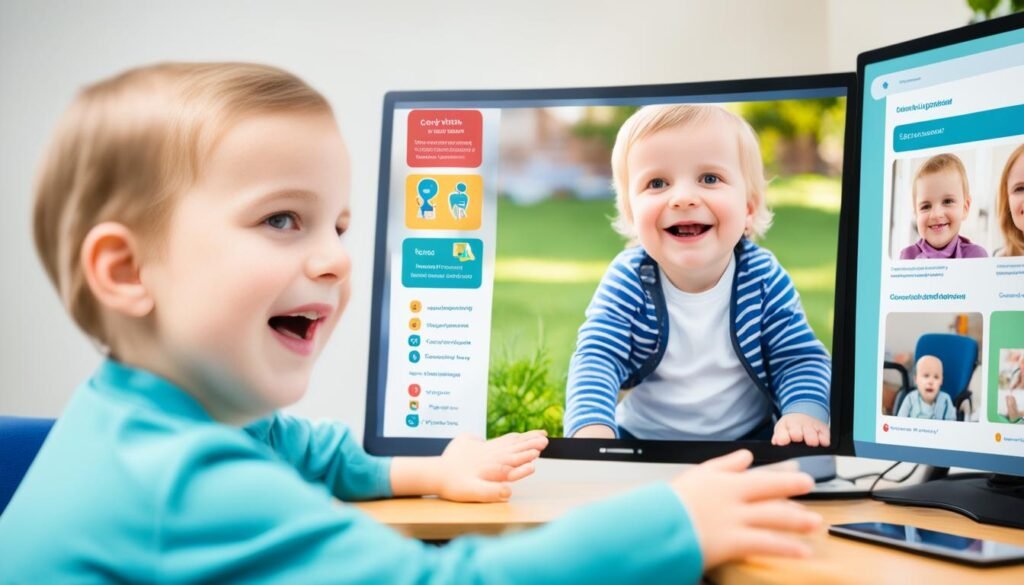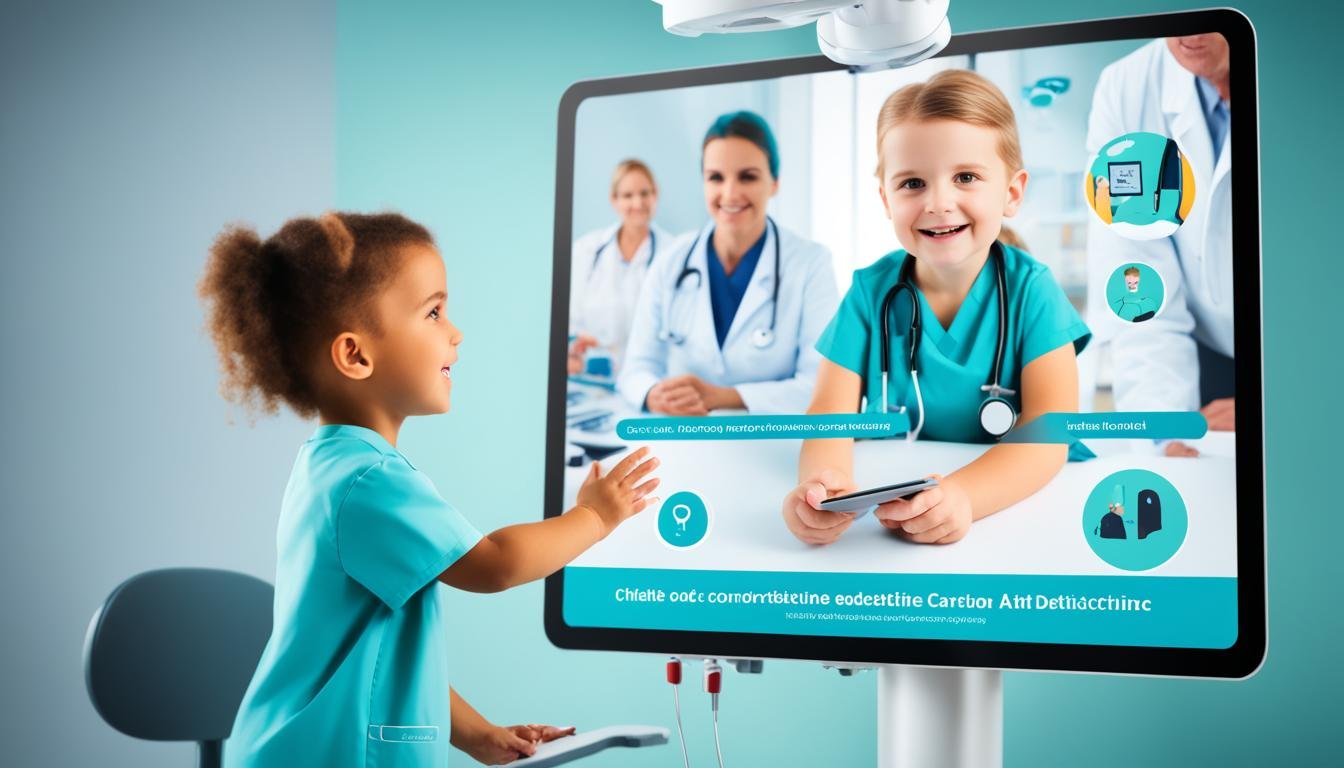Pediatric Care Goes Digital: Child Health Telemedicine
Have you ever wondered how digital technology is transforming pediatric care? Is it possible to provide high-quality healthcare services to children through virtual platforms? The answer lies in the world of child health telemedicine, where innovative solutions are revolutionizing the way pediatric care is delivered.
Telemedicine, the practice of remote healthcare delivery using telecommunications and information technology, is gaining momentum in the field of pediatrics. With the advent of virtual consultations, online pediatric consultations, and telehealth solutions for pediatrics, children can now receive quality healthcare from the comfort of their own homes.
But what are the benefits of telemedicine for children? How does it support pediatric care in underserved regions and low-income countries? And what are the trends shaping the future of child health telemedicine?
In this article, we will explore the evolution of telemedicine in pediatrics, the advantages it brings to pediatric patients, its role during the COVID-19 pandemic, and its potential in supporting children with special healthcare needs. We will also discuss the challenges and barriers that hinder the widespread use of telemedicine in pediatric care, as well as policy recommendations for a more accessible and equitable healthcare system.
Key Takeaways:
- Telemedicine is transforming pediatric care, offering virtual consultations and online pediatric consultations.
- Benefits of telemedicine for children include convenient access to healthcare, improved coordination among clinicians, and better health outcomes.
- The COVID-19 pandemic accelerated the adoption of telemedicine in pediatrics, ensuring continuity of care during disruptions.
- Telemedicine plays a vital role in supporting children with special healthcare needs, providing continuity of care and improving quality of life.
- Challenges such as limited access to technology, high costs, and regulatory barriers need to be addressed for the widespread implementation of telemedicine in pediatric care.
The Evolution of Telemedicine in Pediatrics
Telemedicine in pediatrics has witnessed a remarkable evolution, driven by technological advancements and the changing landscape of healthcare. With the emergence of pediatric telehealth, the delivery of care for children has undergone significant transformation.
The development of telemedicine in pediatrics has introduced a range of innovative modalities, including live interactive video visits, remote patient monitoring, and store-and-forward consultations. These telehealth technologies have revolutionized the way healthcare is delivered to pediatric patients, enabling timely access to specialized care and reducing geographical barriers.
“Telemedicine has become an indispensable tool in the medical home model of care, ensuring continuity and coordinated healthcare services for children,” says Dr. Emily Johnson, a renowned pediatrician. “It has facilitated the delivery of pediatric subspecialty care, enabling remote evaluation, consultation, and management of complex conditions. Telemedicine has also played a pivotal role in providing mental and behavioral health services to children.”
The COVID-19 pandemic further accelerated the adoption of telemedicine in pediatrics. With the need for social distancing and reducing exposure to potential infections, telehealth emerged as a safe and effective solution for pediatric care. It allowed healthcare providers to deliver care while ensuring the safety of patients and clinicians.
“Telemedicine has been a game-changer during the pandemic,” states Dr. Sarah Thompson, a pediatric telehealth specialist. “It has enabled us to provide essential care to children without the need for in-person visits. Through virtual consultations and remote monitoring, we have been able to address acute illnesses, manage chronic diseases, and support preventive care.”
As pediatric telehealth continues to evolve, addressing barriers to access, ensuring clinician expertise, and establishing robust technological infrastructure are key factors for its success. Payment policies that support equitable and high-quality care are also crucial in driving the adoption and sustainability of pediatric telemedicine.
“The evolution of telemedicine in pediatrics holds immense potential for transforming the healthcare landscape for children,” asserts Dr. Michael Evans, a leading advocate for pediatric telehealth. “By embracing telemedicine and overcoming the challenges it presents, we can improve access to care, enhance health outcomes, and create a patient-centric healthcare system for pediatric patients.”
The Growth of Pediatric Telehealth
Over the years, the growth of pediatric telehealth has been remarkable. According to recent studies, the use of telemedicine in pediatric care has seen a significant increase, with healthcare providers recognizing its potential to improve accessibility and efficiency.
Telemedicine Adoption: The adoption of telemedicine in pediatrics has been driven by its ability to connect patients with specialists and reduce the need for travel. It has been particularly valuable for children in rural or underserved areas, where access to specialized care is limited.
Improved Healthcare Delivery: Telehealth technologies have enabled pediatricians to remotely monitor patients with chronic conditions and provide personalized care plans. This has helped in managing diseases effectively, reducing hospital readmissions, and enhancing overall patient outcomes.
Enhanced Mental Health Services: Mental and behavioral health services for children have greatly benefited from telemedicine. By providing virtual access to therapists and counselors, children can receive timely support and intervention, improving their mental well-being.
Coordination of Care: Telemedicine has facilitated better coordination among healthcare providers, allowing for seamless care transitions and improved communication. Pediatricians, specialists, and other healthcare professionals can collaborate to develop comprehensive treatment plans for patients.
The Future Outlook: The future of telemedicine in pediatrics looks promising. The continued advancement of technology, coupled with the growing acceptance of telehealth, will further drive its integration into pediatric care. As telemedicine evolves, it has the potential to revolutionize the way healthcare is delivered to children, ensuring access to high-quality care regardless of geographical barriers.
Benefits of Telemedicine for Pediatric Patients
Telemedicine provides numerous benefits for pediatric patients, offering convenient access to healthcare services and improving the overall quality of care. Children residing in remote or underserved areas can now receive medical consultations and follow-up appointments without the need for travel. This eliminates the logistical challenges and reduces waiting times, providing utmost convenience for families.
One of the major advantages of telemedicine is its ability to ensure continuity of care for children with chronic conditions. Regular check-ins and follow-up visits can be conducted remotely, allowing healthcare providers to monitor the child’s progress and make necessary adjustments to the treatment plan. This proactive approach contributes to better health outcomes and reduced hospital admissions.
Telemedicine also facilitates enhanced communication and collaboration between clinicians, caregivers, and other stakeholders involved in the child’s care. With real-time virtual consultations, parents can easily express their concerns, provide updates on the child’s condition, and actively participate in the decision-making process. This leads to better-coordinated care and improved patient satisfaction.
Furthermore, telemedicine plays a crucial role in supporting early intervention and educational initiatives for children with special healthcare needs. Through online platforms, therapists and educators can engage with pediatric patients, assess their developmental progress, provide therapy sessions, and offer educational support. This promotes timely intervention and enhances the child’s overall well-being.
Telemedicine offers convenient access, ensures continuity of care, enhances communication and collaboration, improves health outcomes, and supports early intervention and educational initiatives for pediatric patients.
By leveraging technological advancements, telehealth solutions contribute to an improved quality of life for children, empowering them to receive the care they need regardless of their location. However, it is important to proactively address barriers such as limited internet access in underserved areas and ensure equitable access to telemedicine services for all pediatric patients.
| Benefits of Telemedicine for Pediatric Patients |
|---|
| Convenient access to healthcare services |
| Continuity of care for children with chronic conditions |
| Enhanced communication and collaboration among stakeholders |
| Improved health outcomes and reduced hospital admissions |
| Support for early intervention and educational initiatives |
Telemedicine in Pediatric Care during the COVID-19 Pandemic
The COVID-19 pandemic has had a significant impact on the delivery of pediatric care, necessitating rapid adaptations to ensure continued access to healthcare services. As public health measures and restrictions on in-person visits were implemented, telemedicine emerged as a critical tool in maintaining the provision of care for pediatric patients. Pediatricians and subspecialists swiftly transitioned to virtual visits, enabling the continuity of care despite disruptions.
Telemedicine provided a safe alternative for managing acute illnesses, chronic diseases, and preventive care for children. It facilitated timely consultations, medication management, and mental health support, ensuring that children and their families received the care they needed during this challenging time. The flexibility of telehealth modalities, including live video visits and remote monitoring, allowed for comprehensive care delivery, addressing various healthcare needs.
“Telemedicine provided a safe alternative for managing acute illnesses, chronic diseases, and preventive care for children.”
However, the success of telemedicine during the pandemic also shed light on important considerations. The availability of digital infrastructure and equitable access to telehealth services took the spotlight as essential factors for ensuring equal opportunities for virtual care. In addition, the issue of payment parity emerged, highlighting the need for fair and consistent reimbursement policies to support the continued use of telemedicine in pediatric care.
The COVID-19 pandemic accelerated the integration of telemedicine in pediatric care, emphasizing its potential to deliver accessible and high-quality healthcare. As the healthcare landscape continues to evolve, telemedicine will play an increasingly crucial role in improving healthcare outcomes for pediatric patients.
Telemedicine for Special Healthcare Needs in Pediatrics
Telemedicine plays a vital role in supporting children with special healthcare needs. It provides continuity of care for medically fragile children and those with disabilities. Telehealth for Medically Fragile Children can facilitate remote monitoring of vital signs, medication management, and therapeutic interventions for these vulnerable populations.
Telemedicine enables virtual consultations with multiple specialists, reducing the need for transportation and minimizing healthcare-associated risks. This is especially beneficial for children with disabilities who may face challenges in physically accessing healthcare facilities. By leveraging telehealth solutions, children with special needs can receive timely and comprehensive care, leading to improved health outcomes and enhanced quality of life.
The Pediatric Telehealth for Disabilities provides opportunities for parents and caregivers to actively participate in managing their child’s health. It allows them to play an essential role in medication adherence, therapy sessions, and overall care coordination from the comfort of their own homes. This not only promotes convenience but also empowers families to take an active role in their child’s well-being.
Pediatric Telemedicine: Benefits for Special Healthcare Needs
The advantages of telemedicine in pediatric care for children with special healthcare needs are numerous. It eliminates geographical barriers, allowing children to access specialized medical services regardless of their location. It also reduces the burden on families by minimizing the need for frequent and long-distance travel to medical appointments.
One of the major benefits of Telemedicine for Children with Special Needs is the ability to provide timely and ongoing care without disruptions. Regular virtual visits enable healthcare providers to monitor the child’s condition, adjust treatment plans, and address emerging issues promptly. This proactive approach can significantly enhance health outcomes and prevent complications.
“Telemedicine brings medical expertise directly into the homes of children with special healthcare needs, providing them with the care they require while minimizing the potential risks associated with in-person visits.” – Dr. Emma Thompson, Pediatric Telehealth Specialist
The use of telemedicine for children with special healthcare needs also encourages collaboration among healthcare providers, including specialists, therapists, and educators. Through virtual consultations, they can discuss treatment plans, share insights, and develop comprehensive care strategies to support the child’s overall development.
Furthermore, telemedicine provides access to interdisciplinary services, such as speech therapy, occupational therapy, and behavioral support, which are crucial for children with disabilities. By connecting with a range of specialists through virtual platforms, children can receive comprehensive care that addresses their unique needs.
Comparison of In-person Care and Telemedicine for Children with Special Healthcare Needs
| Aspects | In-person Care | Telemedicine |
|---|---|---|
| Geographical accessibility | Restricted by location | Accessible from anywhere |
| Travel requirements | Frequent and long-distance travel for appointments | Eliminated or minimized |
| Continuity of care | Disruptions due to travel, emergencies, or unforeseen circumstances | Consistent and ongoing care |
| Specialist collaboration | Limited opportunities for interdisciplinary consultation | Enhanced collaboration and care coordination |

Overall, telemedicine presents a transformative approach to providing healthcare for children with special needs. It offers convenience, accessibility, and collaboration, ensuring that these children receive timely and comprehensive care to support their health and well-being.
Challenges and Barriers to Telemedicine in Pediatric Care
Despite the numerous advantages, telemedicine in pediatric care faces several challenges and barriers. Limited access to technology and internet connectivity can hinder the adoption of telehealth, especially in underserved populations. The costs associated with telemedicine equipment and maintenance can be prohibitive for some healthcare institutions. Legal and regulatory frameworks may also pose obstacles, as the regulations surrounding telemedicine vary across states and countries.
Additionally, there may be concerns about the quality and safety of virtual care compared to in-person visits. Privacy and security issues related to telehealth platforms and the protection of sensitive patient information need to be addressed. Overcoming these challenges requires investment in digital infrastructure, policy changes, and increased awareness and education about telehealth benefits for pediatric care.
“The success of telemedicine in pediatrics relies on addressing barriers to access, ensuring clinician expertise, technological infrastructure, and payment policies that support equitable and high-quality care.”
Efforts should be made to bridge the digital divide and provide equitable access to telehealth services, particularly in underserved areas. This includes improving internet connectivity, providing affordable or subsidized technology, and increasing digital literacy among patients and healthcare providers.
Furthermore, healthcare institutions need to allocate resources for the implementation and maintenance of telemedicine equipment and platforms. The financial burden associated with telemedicine should be carefully considered to ensure its long-term sustainability and accessibility.
Standardizing telemedicine regulations and licensing requirements across states and countries can streamline the adoption and practice of telehealth in pediatrics. Clear guidelines and policies can help healthcare providers navigate legal and regulatory challenges, ensuring compliance and patient safety.
Privacy and security measures must be implemented to protect patient data and maintain confidentiality in telehealth interactions. Healthcare organizations should invest in secure telehealth platforms and train healthcare providers in best practices for data protection.
“Overcoming the challenges and barriers to telemedicine in pediatric care requires a multi-faceted approach, including technological advancements, policy changes, and stakeholder collaboration.”
Increasing awareness and education about telehealth benefits for pediatric care is crucial for its successful implementation. Efforts should be made to educate both healthcare professionals and the general public about the effectiveness, safety, and convenience of telemedicine in addressing the healthcare needs of children.
In conclusion, while telemedicine in pediatric care offers numerous advantages, it also faces challenges and barriers that need to be addressed for its widespread adoption and success. By investing in digital infrastructure, implementing supportive policies, improving access to technology, and ensuring privacy and security, the potential of telemedicine can be fully realized, providing quality and equitable healthcare for all children.
The Future of Telemedicine in Pediatric Care
The future of pediatric care is intertwined with the advancement of telemedicine. As technology continues to evolve, telehealth will become an even more integrated and essential component of clinical practice in child health. Artificial intelligence (AI) and remote monitoring devices will revolutionize diagnosis and treatment, enabling more personalized and precise care for children. Virtual reality (VR) and augmented reality (AR) technologies hold the potential to enhance patient engagement and make virtual visits more interactive and immersive.
Integrating telemedicine with electronic health records (EHRs) and health information exchange (HIE) systems will streamline workflows and enable seamless communication among healthcare providers. This integration will enhance care coordination and ensure that all pertinent patient information is readily accessible during virtual consultations.
The ongoing research and development in telehealth will pave the way for new applications and innovations in pediatric care. Novel telemedicine solutions will emerge, offering novel and patient-centered care models that cater specifically to the needs of children.
Virtual Reality and Augmented Reality:
Virtual reality and augmented reality technologies have transformative potential in pediatric telemedicine. VR can create immersive environments that simulate real-life situations, aiding in medical education and training. AR can overlay virtual elements onto the real world, assisting with procedures, guiding clinicians, and enhancing patient engagement. These technologies will contribute to the growth and effectiveness of telemedicine in pediatrics.
Artificial Intelligence and Remote Monitoring:
The integration of artificial intelligence and remote monitoring devices will revolutionize pediatric care. AI algorithms can analyze vast amounts of patient data and assist in diagnosing and managing diseases. Remote monitoring devices, such as wearable health trackers and biosensors, will enable continuous monitoring of vital signs and other health indicators. This combination of AI and remote monitoring will facilitate early detection of health problems and allow for timely interventions.
Streamlined Workflows and Communication:
The integration of telemedicine with electronic health records and health information exchange systems will streamline workflows and facilitate seamless communication between healthcare providers. Access to real-time patient data and secure communication channels will enable efficient collaboration, reducing delays in care and improving patient outcomes.
The future of telemedicine in pediatric care holds immense promise, with technology-driven advancements paving the way for improved access, quality, and outcomes in child health. By embracing these advancements and addressing the associated challenges, the healthcare community can create a future where telemedicine plays a central role in delivering comprehensive and patient-centered pediatric care.
Policy Recommendations for Telemedicine in Pediatric Care
To ensure the continued growth and success of telemedicine in pediatric care, policymakers have a critical role to play in developing comprehensive guidelines and regulations. By implementing clear and consistent policies regarding reimbursement, licensure, and scope of practice for clinicians practicing telehealth, we can create a supportive environment for the delivery of virtual healthcare services to children.
“Telemedicine in pediatric care has immense potential, but it requires a well-defined policy framework to guide its implementation and ensure equitable access for all children.”
One crucial aspect is ensuring that both Medicaid and private insurance coverage include telemedicine services for pediatric care. This will help remove barriers to access and ensure that all children can benefit from the convenience and quality of virtual consultations and follow-ups.
Data privacy and security are also paramount in virtual care settings. By prioritizing the protection of patient confidentiality, policymakers can build trust and confidence in telemedicine, encouraging widespread adoption. Robust regulations should be put in place to safeguard sensitive patient information and secure telehealth platforms.
It is essential to address disparities in digital access and literacy to ensure equitable opportunities for all children. Policymakers should focus on bridging the digital divide, particularly for those from low-income backgrounds or underserved communities, to guarantee that they can equally access and benefit from telehealth services.
Collaboration between government agencies, healthcare providers, and technology companies is key to fostering the development of effective telemedicine policies. By working together, we can establish guidelines that prioritize high-quality and equitable care for pediatric patients.
The table below summarizes the policy recommendations for telemedicine in pediatric care:
| Policy Recommendations |
|---|
| Clear and consistent policies for reimbursement, licensure, and scope of practice |
| Inclusion of telemedicine services in Medicaid and private insurance coverage |
| Data privacy and security regulations |
| Addressing disparities in digital access and literacy |
| Collaboration between government agencies, healthcare providers, and technology companies |
By implementing these policy recommendations, we can create an environment where telemedicine flourishes in pediatric care, improving healthcare access, enhancing patient outcomes, and transforming the way we deliver healthcare to children.
Conclusion
Telemedicine has revolutionized pediatric care, providing convenient access to healthcare services and improving health outcomes for children. As demonstrated during the COVID-19 pandemic, telehealth played a critical role in ensuring continuity of care during disruptions. With its ability to enhance coordination among healthcare providers and offer remote consultations, telemedicine has the potential to transform pediatric care into a more patient-centered and efficient healthcare system.
Although there are challenges and barriers to overcome, the future of telemedicine in pediatrics looks promising. Policy changes, investments in digital infrastructure, and increased awareness are necessary to ensure equitable access to telehealth services for all pediatric patients. By prioritizing patient privacy, addressing disparities in digital access, and integrating telehealth into existing healthcare systems, pediatric telemedicine can continue to revolutionize care delivery and improve health outcomes for children.
In summary, pediatric telemedicine has provided a path to convenient and high-quality healthcare services for children. It has shown its value during the pandemic and has the potential to shape the future of pediatric care. With continued advancements in technology and the implementation of supportive policies, telemedicine will play an increasingly vital role in pediatric healthcare, ensuring that children receive the care they need when and where they need it.






